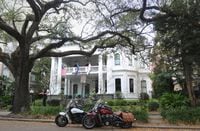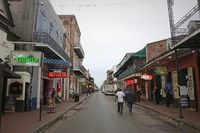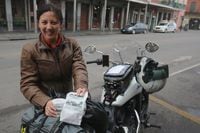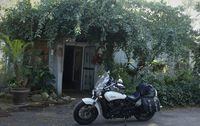The Indian Scout and Scout Sixty have gotten us to New Orleans, Louisiana. The air is thick and sort of difficult to swallow. Humid is what they call it; ‘balmy’ is the word Kyra likes to use. The palm trees in front of our hotel sway one way and then the other with help from giant gusts of wind. The clouds lay over us in layers, each getting darker as you go up. We walk adjacent to the St. Charles Street Car, following its lines into the French Quarter, a place all too familiar for more than a few people. Crowded is an understatement. But, as someone might suggest, "you have to see it once." Booze is abundant and the open doors of eating and drinking establishments line both sides of the street, music escaping. This is the Big Easy.
We didn't take our time getting here - riding nearly 400 miles in one shot - eyes all dry and bloodshot, our feet and fingers tingling from 10 hours in the saddle. No motorcycle, I don't care how comfy, can make up for the fact that you stay in one spot all day, for hours. And so our arrival to a typical hotel just outside of the city was long overdue. We slept hard, the way people sleep when they've had one too many, or when they’ve spent the better part of their day rumbling down the Interstate. When we last spoke, we were in Austin - the craft beer, locally sourced, non-GMO, pour-over coffee capital of Texas, a state known for none of that. After our adventures in ATX, we headed south toward Galveston, an island city on the Gulf Coast of Texas. We stayed the night just off the island in an Airbnb near Seabrook. It was a short ride – just over 200 miles the way we went – so we took advantage of the extra hours and handled some belated business. The following morning, we rode onto the island and explored a bit. We found a quaint little coffee shop at one end, ate an early lunch and then cruised the coast line bound for a ferry that would shuttle us and our Indians to the Bolivar Peninsula. Honestly, I don’t have a lot to say about the island itself. Clearly a tourist destination for those with homes in Houston. It boasts a pair of giant pyramids (Moody Gardens) full of sharks and monkeys and stuff, as well as an assortment of tourist trap eateries and watering holes.
Having grown up in Washington, I’m quite accustomed to taking a transit ferry. And a lot like the M/V’s that move cars, motorcycles, motorhomes and people all over the Puget Sound, the Galveston-Bolivar ferry promptly pulled away from port and safely delivered us to the other side within a half-hour, for free none the less! Once off the boat, we followed SH 87 along the water, gawking at the massive and wildly colorful homes built on beams that lined the coast. Then we turned inland, and aside from a rather interesting coffee stop and conversation in Port Arthur, the view from our office looked pretty similar for the next few hundred miles: a long, straight stretch of pavement, lined on both sides by tall palms or lowland swamp. Then night fell, and the rest of our ride was clouded in darkness, battling a wild wind that slammed into the side of our Indians, moving us across lanes while we yelled into our headsets to be sure each of us was alright. Needless to say, our arrival at the aforementioned hotel on the outskirts of New Orleans was highly anticipated, and much appreciated.
New Orleans is something I’ve been looking for. Something that inspires me. Something that leaves me holding my hands out, asking for more, knowing full well that what I’ve had is more than enough. Kyra had been before, but was working, so her ability to appreciate what it has to offer was limited at best. I, on the other hand, had never seen her streets, heard her loud noises or stumbled out of her establishments as so many do, and so I was eager as ever to explore. Bourbon Street is something you’re supposed to do, and so we did. We drank absinthe at the Old Absinthe House, a place where, according to legend, Andrew Jackson and Pirate Jean Lafitte once met upstairs where they planned the victory of the battle of New Orleans, which would end the War of 1812. It is also an establishment that has been frequented by the likes of Oscar Wilde, Mark Twain, General Robert E. Lee, Franklin Roosevelt and Frank Sinatra, among others. Our next stop was Lafitte’s Blacksmith Shop which sits on the corner of Bourbon Street and St. Philip. According to the internet, it is “the oldest structure in the U.S. housing a bar.” And while it may have once housed a fine eating and drinking establishment, it is now full of drunken forty-somethings, jamming their credit cards into the digital jukebox in order to play hits from their long lost youth.
With our heads screwed on straight and looking for an excuse to avoid the idiocracy that is NOLA at night, we wandered across town to a tiny wine-store-meets-outdoor-café that our friend Christopher had suggested. We ate cheese and bread and drank red wine and then caught an Uber back to our hotel, The Columns, an 1883 Italianate mansion that overlooks the St. Charles streetcar line. From there we wandered even further on foot, exploring the Garden District neighborhood, feeling small in front of the colonial mansions that have housed an array of personalities for more than 200 years. The next morning we stopped at the famed Café Du Monde for beignets and black coffee – another something people say you’re supposed to do, and something that I will henceforth tell people to do. No questions asked.
Our eventual and rather unfortunate escape from the city was a tough one for me. This was the first time I had honestly fallen in love with a place, and the idea of coming back has not left my mind since. I’ve been fortunate enough to have traveled all of the world. To have visited the exotic, the extreme, the interesting and the must-see. But NOLA, with her big beautiful homes and her colonial-meets-French cottages and balconies, her clash of cultures and balmy weather has me smitten. Like a middle school kid after his first kiss. And I’m coming back. Soon. And maybe I’ll stay for a while this time.










/cloudfront-us-east-1.images.arcpublishing.com/octane/XQY36GGAPMH32BCWJGVMVLRMZQ.jpg)









/cloudfront-us-east-1.images.arcpublishing.com/octane/MUQLOVLL2ZDGFH25ILABNBXKTI.jpg)
/cloudfront-us-east-1.images.arcpublishing.com/octane/TNOU5DNE2BC57MFPMGN2EIDXAM.jpg)
/cloudfront-us-east-1.images.arcpublishing.com/octane/GTCXACQGJ5HAPDTGWUQKDEH44E.jpg)
/cloudfront-us-east-1.images.arcpublishing.com/octane/S35YGSEMEZB4BLTDJTSZPF4GLA.jpg)
/cloudfront-us-east-1.images.arcpublishing.com/octane/5UOT6HPX2JFMRJAX6EH45AR4MQ.jpg)
/cloudfront-us-east-1.images.arcpublishing.com/octane/OKWOJWAKP5EP3OACCRRWPCIX2Q.jpg)
/cloudfront-us-east-1.images.arcpublishing.com/octane/2WF3SCE3NFBQXLDNJM7KMXA45E.jpg)
/cloudfront-us-east-1.images.arcpublishing.com/octane/G4MG6OUCJNBSHIS2MVVOTPX65E.jpg)
/cloudfront-us-east-1.images.arcpublishing.com/octane/IIGGWFOTOJGB7DB6DGBXCCMTDY.jpg)
/cloudfront-us-east-1.images.arcpublishing.com/octane/QSTCM6AVEZA5JJBUXNIQ3DSOF4.jpg)
/cloudfront-us-east-1.images.arcpublishing.com/octane/U4I7G625B5DMLF2DVIJDFZVV6M.jpg)
/cloudfront-us-east-1.images.arcpublishing.com/octane/B6XD6LS6IVCQPIU6HXDJSM3FHY.jpg)
/cloudfront-us-east-1.images.arcpublishing.com/octane/ICL63FEDDRDTTMINYICCEYGMDA.jpg)
/cloudfront-us-east-1.images.arcpublishing.com/octane/FCGZHQXRBZFLBAPC5SDIQLVF4I.jpg)
/cloudfront-us-east-1.images.arcpublishing.com/octane/WNOB6LDOIFFHJKPSVIWDYUGOPM.jpg)

/cloudfront-us-east-1.images.arcpublishing.com/octane/X33NU3E525ECRHXLNUJN2FTRKI.jpg)
/cloudfront-us-east-1.images.arcpublishing.com/octane/6KKT5NNL2JAVBOXMZYS5ZO76YA.jpg)
/cloudfront-us-east-1.images.arcpublishing.com/octane/J5RKG5O455GMPGQRF2OG6LRT7A.jpg)
/cloudfront-us-east-1.images.arcpublishing.com/octane/GX2CIZKQVRH2TATDM26KFG2DAE.jpg)
/cloudfront-us-east-1.images.arcpublishing.com/octane/ZWIDYSAKQZHD5BHREMQILXJCGM.jpg)
/cloudfront-us-east-1.images.arcpublishing.com/octane/CYUHJZCTSJCH3MRAQEIKXK7SCQ.jpg)
/cloudfront-us-east-1.images.arcpublishing.com/octane/LKOFINY56FCXJCANJ5M7ZDQUBY.jpg)
/cloudfront-us-east-1.images.arcpublishing.com/octane/4NBPDACMWJH63JQYJVK3QRBDZI.jpg)